
After leaving the extraordinarily biodiverse Nagarahole-Bandipur landscape in the southern state of Karnataka, I struck out for the North, catching a fourteen-hour overnight train from Mysuru to Hyderabad on May 22-23. The next two days were occupied by a flying visit to Hyderabad (former throne city of diamond-rich Golconda and today’s capital of the Telugu-speaking Telangana state) during which I had just enough time to finish an article, try the city’s famous biryani1, and visit the Sri Chilkur Balaji “Visa” Temple2. I then took a twenty-five-hour train from Hyderabad to Delhi, the historic capital of India from the Mughal Empire and the British Raj through today.
I’d known was I was signing up for when I came to India in the dry season in the Anthropocene, and Mumbai had been, as I expected, very hot indeed, with temperatures reaching over 90°F (32°C). In Karnataka, I had been lucky to experience relatively temperate weather, with robust cloud cover for the time of year and even a few brief but intense rainstorms, bold forerunner-scouts of the great summer monsoon. Then, I arrived in Delhi, and very soon was experiencing even more heat than I had bargained for.

It was Seriously Freaking Hot in Delhi. In the days to come, the temperature hit 110°F where I was, and much higher in other parts of the city. On Wednesday, May 29, two temperature stations in New Delhi recorded 49°C (120°F) or higher, record highs for the city’s entire history. So as of the time I’m writing this, I can say that I was in Delhi for its hottest day ever recorded (although that record likely won’t stand for very long).
I didn’t quite realize what I’d gotten into at first; I knew it was really hot, but I had the privilege and resources to buy entry to an air-conditioned Airbnb. I slept through most of Sunday May 26 after arriving in the early morning on the 25-hour train from Hyderabad, then started exploring properly on Monday May 27.
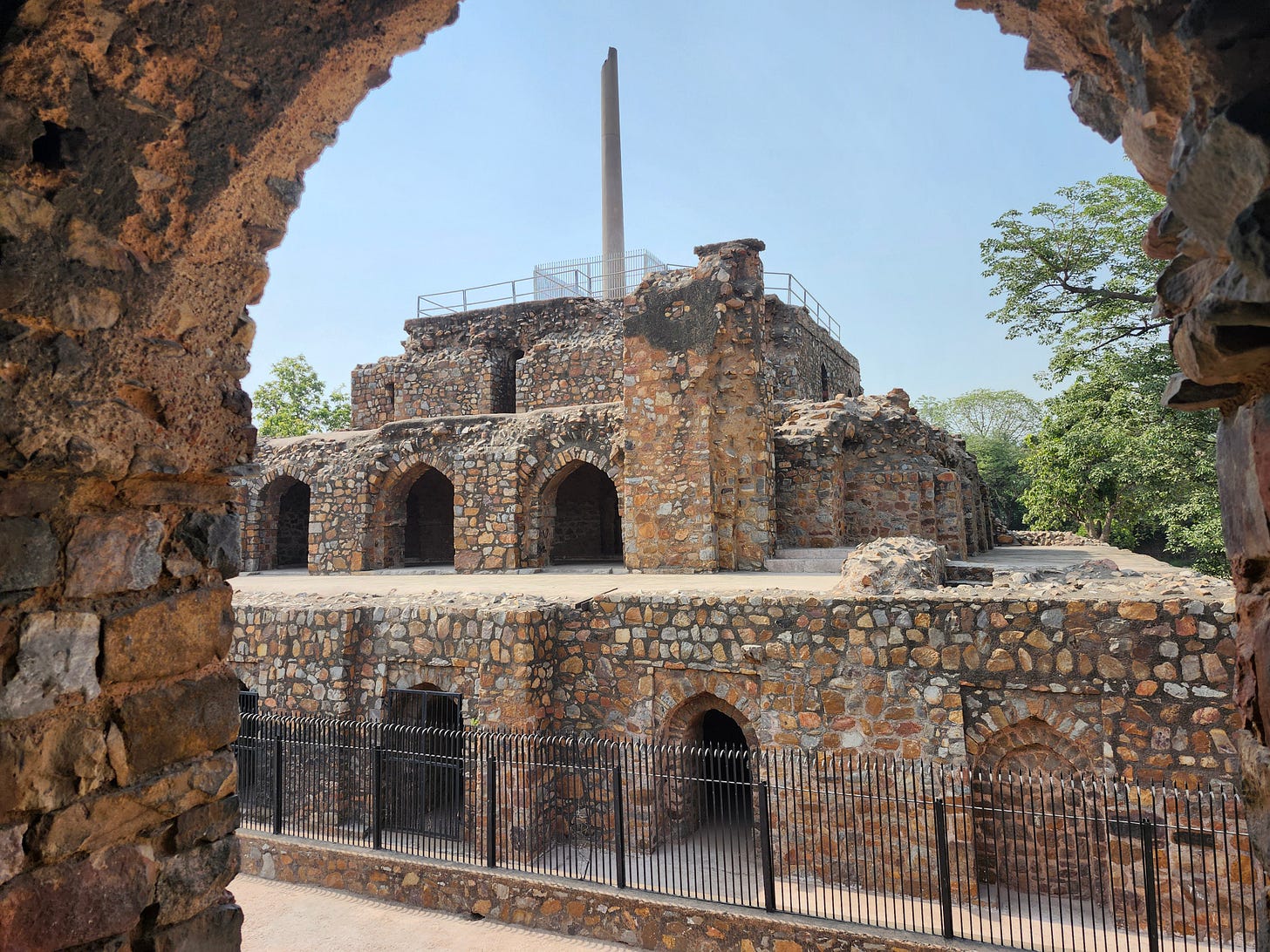
My first visit in Delhi was the Feroz Shah Kotla medieval Islamic fortress/palace complex, a lesser known ruin just a minute or so on foot from my first Airbnb. It was absolutely sweltering as I stepped outside, but my body temperature was low from hours of air-conditioned sleep, the residential-area streets were shaded by serried ranks of buildings, and I brought plenty of water, so it didn’t seem that bad at first. I was awed to see the Pillar of Ashoka that had been moved to this site in 1356 by the eponymous Feroz Shah, a pre-Mughal Sultan of Delhi from the Tughluq Dynasty.
The heat was baking amid the stone ruins, but it was still cooler than than the roads outside. The mere presence of the trees, fed by gushing irrigation hoses, made the monument sites relative oases of coolness, attracting flocks of a group of birds and animals I would come to think of as the “Delhi Monuments Species Community.”
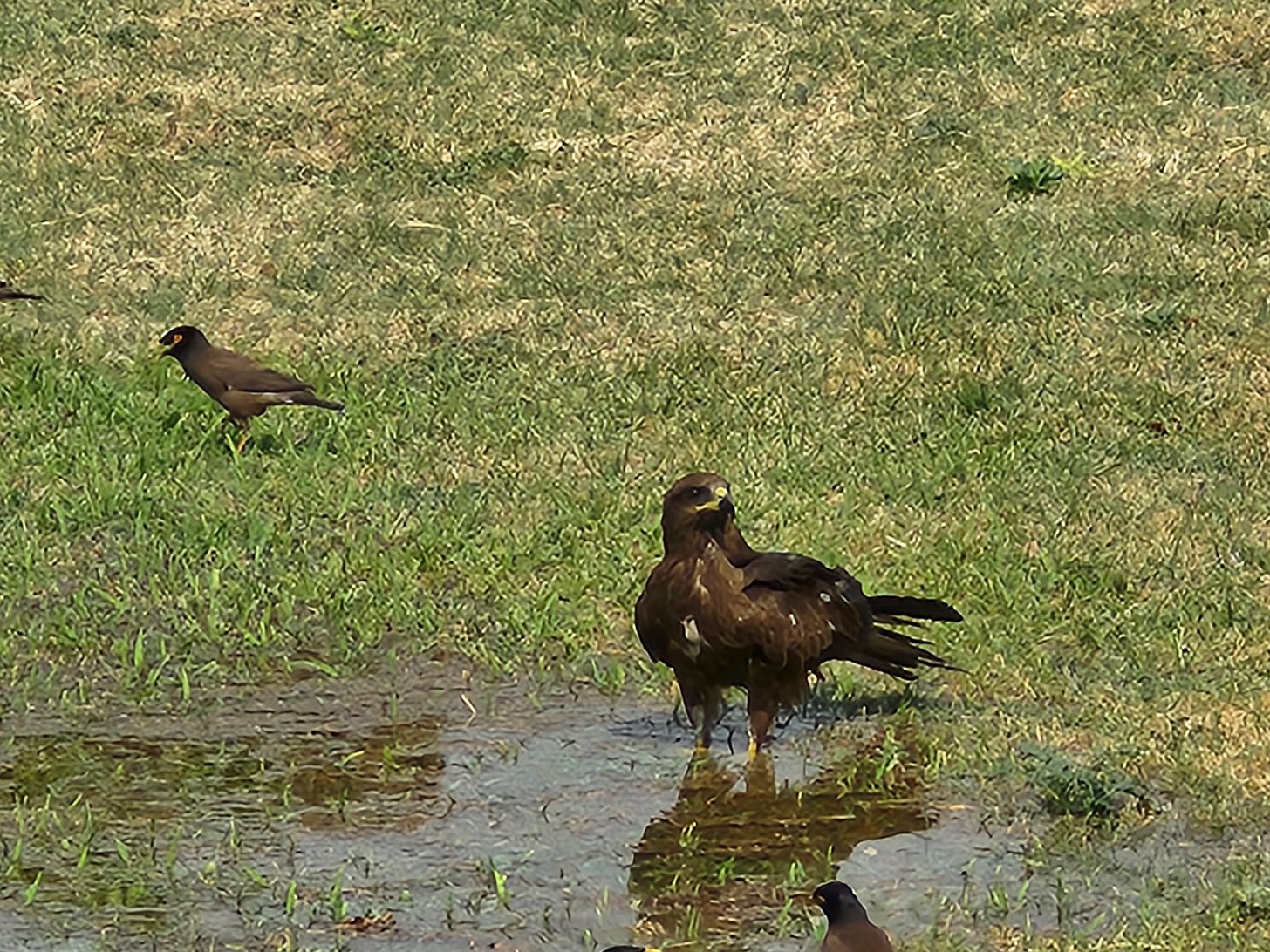
Pigeons, Indian crows, and Indian mynahs were the three most common birds, interspersed with a few colorful lapwings and the odd black kite, a kingly raptor deigning to drink alongside these passerines. Adorable little palm squirrels scampered in the shade of the trees, looking like giant chipmunks, and resting feral dogs nearly blended in with the ground thanks to their beige-brown fur.
By now, I was starting to feel the heat. On my way out of Feroz Shah Kotla, I checked my phone and was interested to note that the temperature in Delhi that afternoon was 108°F, or over 42°C. I think I stood still for about a minute as the penny dropped. This was the point when I began to realize that these circumstances had gone beyond “normal Really Hot” and well into “Really Insanely Very Hot Indeed.”
On the one hand, it might seem that the reasonable thing to do would be to retreat into an air-conditioned cafe or Airbnb; I could buy access to cool temperatures very easily. On the other, I simply felt like taking a walk: I was in a fascinating new city, I still had plenty of water in my backpack (and it was just the light daypack extracted from my big travel pack at the Airbnb), I was feeling in pretty good shape, and there were motor-rickshaws passing by all the time so I could tap out anytime I wanted to. After all, extreme heat was part of what I’d come here to report on!
So from the Feroz Shah Kotla complex, I walked to the Delhi Gate of the Red Fort via the Rajghat, the memorial site where Gandhi was cremated. This was a fairly short distance, less than four kilometers; easy under normal conditions. Today, it was positively punishing. All the birds I saw along the way were clinging to patches of shade with their beaks opened wide, panting from the heat. I actually had to wave away a series of several motor-rickshaw drivers who clearly feared for my sanity once they realized I was actually choosing to walk on a day like this.
On a sidewalk in front of the Red Fort’s Delhi Gate, I saw three men carrying an older man who appeared to have passed out from the heat. I gave them my second backup water bottle, and they poured it on the lips of the unconscious elder, who gasped a bit. Satisfied that he was alive, I continued walking, and the three of them manhandled him into a motor-rickshaw. I hope he recovered swiftly.
This physical manifestation of the negative potentialities of the situation was rapidly limned in my mind as an emphatic example of What To Avoid. After determining that the Red Fort was closed on Mondays and that the attractive-looking neighborhood café I'd seen online did not exist anywhere near where Google Maps said it was, I decided to call it a day and caught a ride back to my lodgings.
Everywhere I went in Delhi in the following days, I felt the punishing heat and saw its impacts. On the ground in the heart of the heatwave, it felt opening-the-oven-door hot, except the oven door was the entire sky. Unexpected phenomena arose at such temperatures. The frames of my glasses felt hot against my face (I’ve worn glasses on and off since childhood, but I didn’t recall ever feeling that before) and the hand sanitizer in my pocket heated up so much that it stung like spilled coffee when it touched my palm. When taking a motor-rickshaw from one Airbnb to another, my phone displayed a rare “System overheating” warning. The last time I’d seen that had been years ago when I’d fallen asleep on a beach with my phone in the full glare of the sun for hours. Occasionally, I would notice that when I started drinking water, I would intend to take only a sip but seemingly couldn't physically stop myself from continuing to drink. The closest sensation I'd previously experienced was how the body reflexively gasps for air when surfacing after an underwater swim. I felt, or perhaps just fancied I felt, the brain stem overriding the cerebrum to demand involuntary acquisition of vital resources.
In his brilliant What If? science comics, Randall Munroe once wrote that a human body, if exposed to certain cosmic events like supernovas, wouldn’t so much “die” of a specific cause as simply “stop being biology and become physics.” This heat felt like the weather had stopped being weather and become…pressure, perhaps, or just “extreme conditions.”
I was to spend the entire remainder of my time in India within the Delhi Metro area, shifting between three Airbnbs in the Feroz Shah Kotla, Laxmi Nagar, and Nizamuddin East neighborhoods for nightly lodgings and visiting various points of interest during the day. (Or, more often, the slightly cooler late afternoon or evening). Everywhere I went in Delhi, I saw the effects of extreme heat.
In the days to come, the temperature reached over 110°F where I was, and considerably higher in other parts of the city. On Wednesday, May 29, two temperature stations in New Delhi recorded 49°C (120°F) or higher, record highs for the city’s entire history. I was here in Delhi for its hottest day ever. So far.
On May 30, I visited the Jama Masjid3, the former imperial mosque of the Mughal emperors and still one of the largest mosques in India. Visitors to the mosque were expected to remove their shoes, but the unprecedented temperatures had heated up the stone floors so much that it hurt to put your feet directly on them. I was wearing socks, but most people weren’t, so the mosque folks had stretched out long thin rolls of cloth to serve as passageways across the scalding stone of the courtyard.
I then spent much of the afternoon in the Red Fort, which was way bigger than I had expected, with 2.41 kilometers of walls enclosing an area of over 100 hectares. In a way, it’s India’s answer to China’s Forbidden City of the Ming and Qing Dynasties: the Red Fort wasn’t just a residence for the Mughal emperors4, but an entire self-contained world for their court, with a multitude of palaces, gardens, baths, wells, pleasure pools, government administration buildings, places of worship, and more.
Even after seeing the major attractions like the jewelled balcony of Shah Jahan’s audience hall, there remained wide areas of the grounds I had yet to explore, some of which were almost deserted. I was amazed; this was an iconic World Heritage Site in a city of over thirty million people, and it was still big enough that there were spots where one could be almost alone amid the trees and half-ruined buildings. It was cooler than the outside of the fort, with the Delhi Species Community much in evidence, but it was still very hot. That evening, I found that so much sweat had evaporated off me during the day that actual ridges of white salt had formed on my clothes.

On May 31, I visited Humayun’s Tomb, forerunner and inspiration for the Taj Mahal, resting place of the second Mughal Emperor as well as over a hundred later family members (because why waste a good tomb). I was particularly surprised to learn that there had once been an entire village living in the enclosure around Isa Khan’s tomb, one of the smaller tombs in the complex; it reminded me of the medieval villagers who’d lived in the ruins of the Roman Colosseum. The trees and fountains made the whole area a relative oasis of coolness; I personally would recommend that the Delhi and/or national government dispense with monument ticket fees for local residents and make the Humayun’s Tomb area public park (at least during daylight hours) in the mode of NYC’s Central Park or Paris’ Bois de Boulogne.
On June 1, 2024, the seventh and final phase of voting in India’s 2024 election kicked off, during which fifteen people died of heatstroke in the nearby state of Uttar Pradesh, and fourteen more in the state of Bihar. Among them were at least 20 election workers. Those losses are horrible, but given that this was the largest democratic election in the history of humanity, with 642 million votes cast at over 1 million polling stations across all seven phases, I think it also counts as a relative triumph of organization. The most populous nation-state in the history of the world just pulled off the core organizing function of a democracy in the teeth of an extreme heatwave.
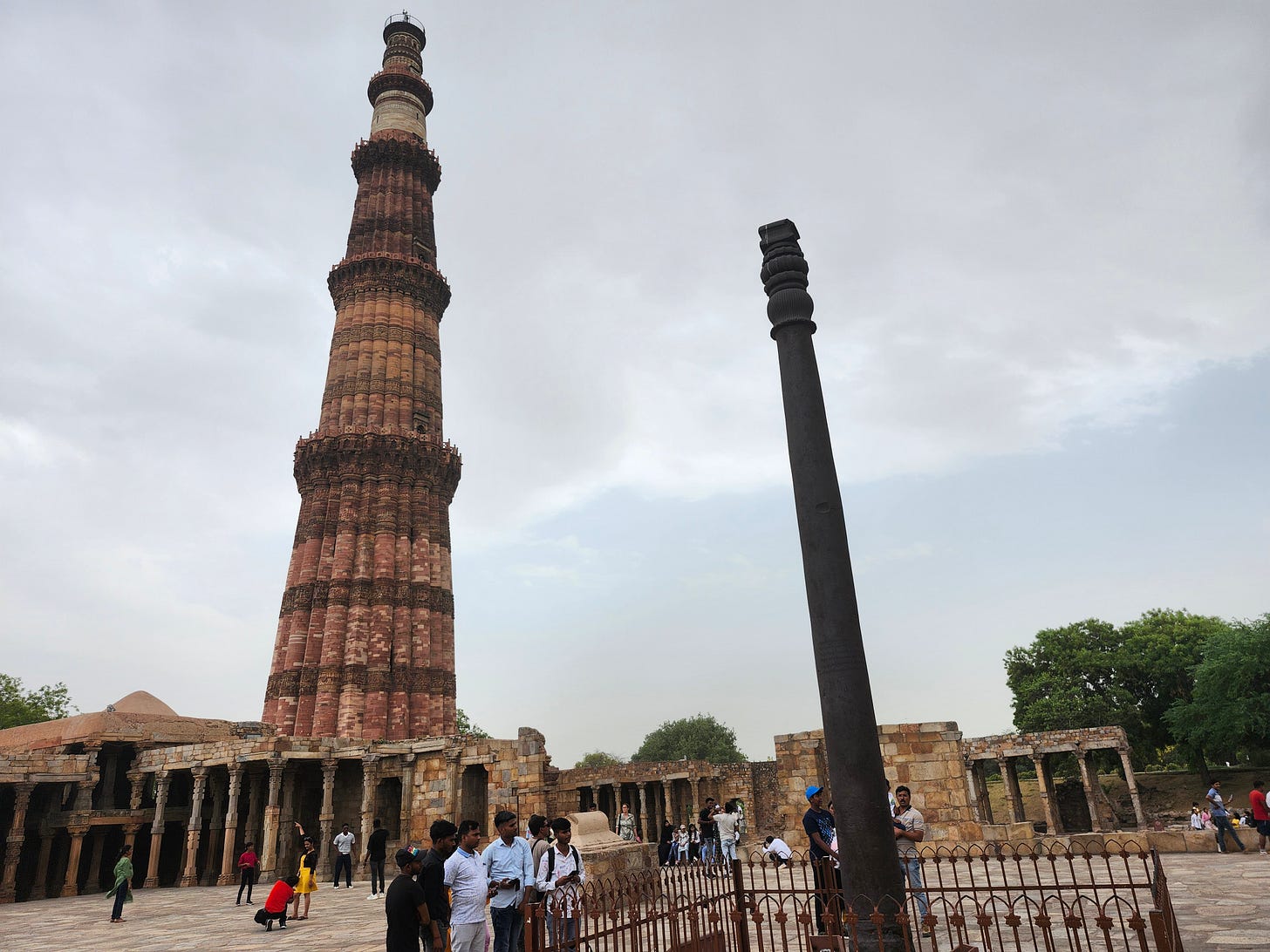
When I visited the Qutb Minar on June 1, the heat was blessedly broken for perhaps half an hour by a passing shower of rain, in a visceral “teaser trailer” that reminded me of the extraordinary ecological and cultural power of the monsoon.

The rain had ended by the time I reached the Ugrasen ki Baoli, an ancient stepwell of mysterious antecedents with unknown builders. It fits within a broader Middle Eastern and South Asian tradition of “bioclimactic architecture,” built to manage heat and natural resources in extreme temperatures; there had been a similar (much smaller) stepwell in the Red Fort as well. I admired the functionality of it; this was public infrastructure for the common good of providing water, but it was still beautiful architecture at the same time, much like a Roman aqueduct or a modern wind turbine.

On June 2 I visited the Yamuna Ghat, an access point to a tributary of the great Himalayan glacier-fed Ganges watershed. The Yamuna River ran through the center of Delhi, and had suffered for it in recent centuries; I wasn’t expecting to see temples and wildlife like I had on the ghat along the Kaveri River at Srirangapatna, but I had read that the Yamuna was one of the most polluted in the world, and I wanted to see it for myself. When I arrived, someone asked if I wanted to purchase a boat ride, and a kid in an Avengers T-shirt rowed me around a bit. I observed the bridges in either direction, the soaring power lines overhead, and the flocks of pigeons accompanying free-ranging cattle grazing and drinking around the trash flotsam on the far bank. I hadn't seen any cattle on the streets of Delhi (unlike Mysuru) but now here they were, what looked like an entire herd along the riverside. I have no idea who they belong to, if anyone.
As we rowed back to shore, I saw billows of black smoke belching from what looked like a jury-rigged metal pipe; I guessed it was from burning trash, a common though dangerous disposal method I'd seen on a small scale across India. And then there was the smell, omnipresent from the moment I’d neared the shore and nearly overpowering from a small rowboat in midriver. An aroma distinctly evocative of a used toilet bowl, to put it mildly, not improved by the sweltering heat. In short, if the environmental movement were a patent medicine, the Yamuna Ghat could be the “Before Taking” photo for its magazine advertisement. But there is hope for its future: human civilization has worked out a well-trodden path to glorious revival for horribly polluted rivers. The developed world is full of such stories; just to take one example, in Paris the Seine used to be an open sewer for centuries, but has been cleaned up so assiduously in recent years that it’s now an attraction for recreational anglers, a home to wild swans, and will be opened for swimming by the 2024 Summer Olympics. One of these years, a richer, clean energy-powered India might just clean up the Yamuna as well.
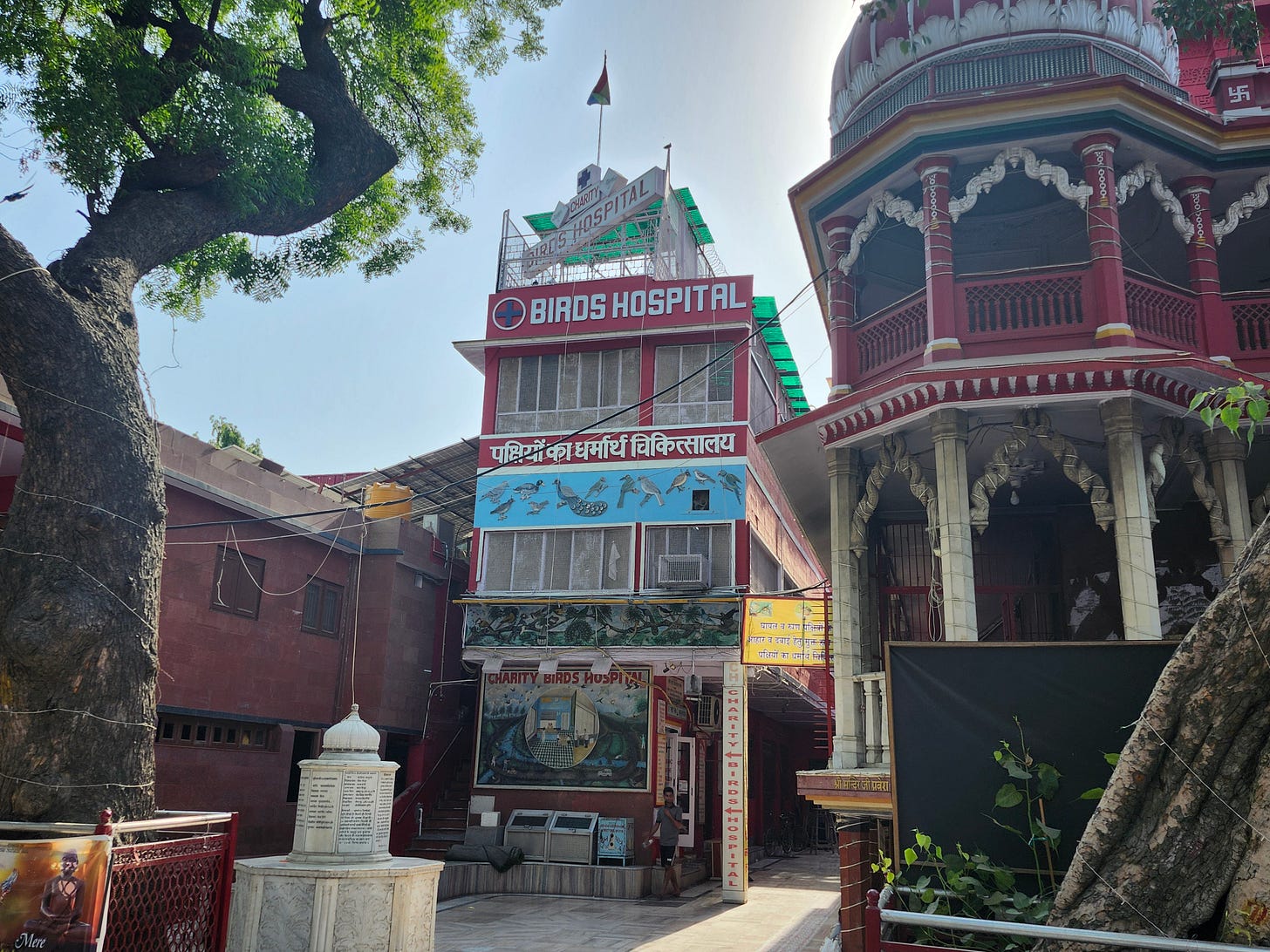
I was heartened by a visit to Delhi’s Jain Charity Birds Hospital, a project of the ancient and traditionally animal-loving Jain faith that had inspired me ever since I first heard of it. It’s exactly what it sounds like: a hospital for birds, working to heal the wounds of wild avifauna found ailing in Delhi. When I visited, I saw cages and enclosures of injured and on-the-mend black kites, rose-ringed parakeets, Alexander parrots, crows, mynahs, and a great multitude of pigeons. Their operating theater was a counter with some bandages and disinfectant, and the little splints and bandages that I recognized as their handiwork nearly moved me to tears. The deeply compassionate folks running the place told me that at the moment, they had approximately 2,500 to 3,000 pigeons, out of about 3,500 total birds. One of the biggest ongoing problems for them was wing injuries due to sharp kite string, and more recently they’d had a surge of birds fallen from the sky with heatstroke. In a delightful twist, I found that the height of the building directly corresponded to the health of the patient within: still-ailing and recently attended to birds were on the main floor, “70% healed” birds on the floor above, and fully healed birds released from the roof, where water and seed had also been left out as a bridge back to independence. I got to release two pigeons myself, and it was absolutely lovely. Humans can be pretty freakin’ awesome creatures sometimes.

And in the waning daylight hours of June 2, I visited the Akshardham, one of the largest Hindu temples5 in the world. (Other contenders include temples in Tamil Nadu, Cambodia, and New Jersey). It was, in the teeth of stiff competition, distinctly the most crowded place I’d been to in India, with the complex and all its labyrinthine access points absolutely packed with devotees despite the residual heat of the evening. The seemingly hour-long queueing process to enter the temple combined the least welcoming features of airport security and a long walk across a hot parking lot, but it was absolutely worth it. The Akshardham is an unbelievably hyper-detailed masterpiece of modern stonework, with over 11,000 artisans and workers contributing to the dizzying hyper-abundance of god, saint, animal, plant, and abstract statues and carvings that adorn every facet. Just to give you an idea of the scale, the Akshardham complex has 148 life-sized solid stone elephant statues, and when I saw them they barely seemed notable compared to everything else in my field of view. Perhaps the most extraordinary part is that its construction began in 2001 and was finished in 2005, making it perhaps the only extra-large temple in the world with an IMAX big-screen theater as an original component. I rather suspect that visiting the Akshardham is the single experience in the world today most similar to going to a cathedral in medieval Europe. This wasn’t a museum or cultural heritage memorial, this was a recently built and highly religious pilgrimage site, where thousands of people who were still alive could point with pride to the bit they’d carved and tens of thousands more came there for their faith, not as tourists. Fascinating stuff.
Reading this article, it may surprise you to learn that I came away from Delhi more optimistic about humanity’s ability to survive extreme heat than when I arrived. Alongside the shocking temperatures, I noticed constant signs of resilience and adaptation even in the middle of Delhi’s worst heatwave ever.
During this time, I often noticed that several major streets were more populous at night than at midday. Resting during the day and going out at night is the oldest and cheapest of heat adaptation techniques: it’s what the leopards of Sanjay Gandhi National Park have done, and strategic siestas have been part of human cultures’ survival package for hot and dry landscapes for millennia. Such shifted circadian rhythms may well become more common in much of the world.
Even very small amounts of technology could produce relative oases of coolness. A tiny local Hindi-signage-only paratha restaurant in the Laxmi Nagar neighborhood had only a shady hole-in-the-wall alcove and a cheap electric fan, but it was positively comfortable. The streets were sweltering, but Delhi was also full of little places where people could find relief.
Relatedly, air conditioners are spreading rapidly across India, quickly becoming a core “must have” appliance in an increasingly electrified country.
I found the Delhi Metro system very impressive; it was large, clean, fast, cheap to ride, on-time, efficient, and blessedly cool. I don’t know how many lives making shaded public transport widely available in Delhi has saved already (the poorest of the poor may not be able to afford even the fraction-of-a-dollar Delhi Metro tickets, and they’re the folks most at risk), but I bet it’s a nonzero number, and I know that a heck of a lot of people have had much, much safer and cooler journeys because of it.
Street carts were selling large bottles of portable fridge-cooled water and even frozen ice cream products at very cheap prices. A cold bottle of water was twenty rupees6, about 25 cents, and carts selling it were everywhere, and very popular. Eventually I was able to go out for the day with only one bottle of water knowing that I could buy more, and I always could. I feel relatively confident in saying that refrigerated beverages and desserts, at least as an occasional luxury, are within the economic reach of the average resident of Delhi today.
India got 5.8% of its electricity from solar in 2023 up from just 0.5% in 2015, as its electricity use continues to grow rapidly thanks to hundreds of millions rising from poverty.
In the first quarter of 2024, renewables accounted for 71.5% of the over thirteen thousand megawatts (over 13 GW) of new electricity generating capacity added to the grid in India, while coal’s share of all of India’s total electricity generation capacity dropped below 50% for the first time since the 1960s!
I personally saw many Tata electric buses while in Delhi, bearing the legend “100% Electric, 0% Smoke.” Locally manufactured e-buses are spreading in India.
India just opened another set of bids for companies to build 2.4 GW more of renewable projects. Their rapid buildout of renewables is showing no signs of slowing down, and that’s spectacular news for the future of human civilization and Earth’s biosphere.
If I had to crystallize one message from my experiences during the Delhi heatwave, it would be this: we as humanity will survive even the worst potential onslaughts of climate change. It will be difficult, but we are gonna make it through this, even in extreme heat-vulnerable Asian megacities. And a lot of us are working hard to help as many wild animals as possible survive along with us.
Seemingly everyone I met in Hyderabad, from my Airbnb host to motor-rickshaw drivers to folks at the temple, insisted that I must try the famous Hyderabad biryani while I was there. I did so, and was duly impressed: a strongly spiced medley of cashews, mushrooms, minced vegetables and other ingredients had been crushed into a paste to form a rich umami-textured masala that was intermixed with un-minced veggies on a bed of long-grained rice. Very good, would recommend.
Hyderabad is home to one of four American consulates in India, so many people apply for visas there. I got to see this firsthand even before I went to the Visa Temple; just as I was stepping into an auto-rickshaw to go to my Airbnb after alighting from the train in the morning, I was halted by the greeting of a young man in the street (I heard his name as Yoganath, I believe) who was grinning from ear to ear. He asked if I was America, enthusiastically shook my hand, then told me proudly and joyously “I got my American visa! I’m going to New York to study computer science.” I congratulated him, and felt a warm glow of patriotism at the sight of such manifest enthusiasm.
Sacred to a local form of Vishnu, the “Visa Temple” was a religious site that had intrigued me ever since I’d first heard about it, as it had become associated with successful prayers to win American student or work visas. I was fascinated by this commingling of religious practice and modern immigration law. When I visited on May 23, 2024, the Sri Chilkur Balaji Temple was absolutely packed, with throngs of devotees filing in through sprawling networks of street vendors. Within the temple, the crowd was so intense that one didn’t so much move forward as be gently carried along by the press of people behind you. The services were in the local Telugu language, which I didn’t understand, but I did catch the call-and-response cry of “GOVINDA!”, one of the many names of Vishnu coming from hundreds of throats.
I then spent a while seeking out and talking with some of the successful and aspiring visa applicants, as well as other temple visitors.
· Karthik, 20, told me that he and his family had come to the temple to celebrate and give thanks for his sister-in-law getting her visa approved to go to the United States, and was happy to introduce me to her. Uma was 22, and with her new visa would be pursuing a Master’s in Cybersecurity from the University of Missouri. She had conducted eleven pradakshinam, ritual circumambulations walking around the temple, on a previous visit requesting that the god assist her visa process. Now that the visa was approved, she had returned today to conduct a full 108 pradakshinams of thanksgiving.
· Saketh was 21, and today was his birthday. He didn’t have a visa yet, but he’d applied for an interview for an American student visa forty days back, and it was now scheduled for June 7th. If approved, he was hoping to use his student visa to go for a Master’s in Computer Science from the University of North Texas. He said that his favorite programming language was Python, and that during his hoped-for educational sojourn he wanted to explore U.S. culture and get a good job as a software developer. This was the first time he had been to the Visa Balaji temple, and I inferred (or perhaps imagined) a Pascal’s Wager-like “it can’t hurt” philosophy behind the visit.
· Ashrita had recently secured an Australian student visa, for a Master’s in IT from Melbourne University. She started working towards that visa in 2022, put on pause when she and her husband had a baby in the meantime. She now cradled her 1.5 year old daughter Hanvika, who would be cared for by her four grandparents during her studies abroad. Afterwards, Ashrita hoped to return to India, rejoin her family, and gain a better job with her new IT skills. She also told me that her brother Saeed was currently studying for a Master’s in Industrial Engineering in Dallas, Texas, USA. He also had come to the Balaji temple once before leaving.
· Rohit, 22, was currently working to finish his MBA. He said his dream was to get a visa and go to the United States, and that he was “trying his level best” to make it happen someday.
· Sreeram had completed a BTEC diploma in engineering, and was hoping for a student visa to study further in the U.S. Interestingly, he also was hoping for a Master’s from the University of North Texas. He’d been waiting 4 to 5 months, but didn’t have an interview scheduled yet. Like Ashrita, he hoped to return to India after studying in America.
· A married couple, Sairam and Jyoti, had come on their anniversary. Sairam’s brother, Saikrishna, had previously received an Australian visa after praying at the Visa Balaji temple, but that wasn’t why they were here. They had much else to give thanks for; as we spoke they were holding their baby son, Veda Vyasa, who they told me was named after the semi-legendary author of the Mahabharata epic. Sairam classed a recent successful real estate deal as a gift from this temple’s god.
"Jama Masjid” basically means “Community Mosque,” so a lot of mosques around the world are named this.
You can remember the six first Mughal emperors with the acronym BHAJSA: Babur, Humayun, Akbar, Jahangir, Shah Jahan, and Aurangzeb. There were many more Mughal emperors later, but from Aurangzeb on the empire began to splinter, reigns grew short and contentious, and by the time the British began to dominate the subcontinent in the latter half of the 1700s, the Mughal emperor was little more than a figurehead in Delhi, with regional figures like the Nawab of Bengal and the Nizam of Hyderabad nominally owing him allegiance but in practice functioning as completely independent monarchs. It was under the “BHAJSA” emperors that Mughal art and architecture flourished, and the globally iconic Mughal monuments were built.
Babur was born a relatively minor Central Asian prince in what is now Uzbekistan, descendant of Genghis Khan on his mother’s side and Tamerlane on his father’s side. He was an “upwardly mobile” warlord, conquering Kabul in 1504 and founding the Mughal Empire with the conquest of Delhi in 1526. Unusually for a conqueror, he also wrote a lengthy and personal detailed autobiography, the Baburnama.
Humayun (ruled 1530-1540 and 1555-1556) famously lost the empire his father had built, then won it back again. He was overthrown by a rebel governor and fled for his life, with his son Akbar born a royal refugee in 1542. Humayun eventually convinced Safavid Persia to support his bid to regain the throne, but died soon afterwards.
Akbar “the Great” (ruled 1556-1605) expanded the Mughal Empire to cover most of the Indian subcontinent, essentially kickstarting the Golden Age of the Mughals. Despite being dyslexic and never learning to read, Akbar was a major patron of philosophy and literature, and was notably open-minded and pluralistic, famously hosting peaceful debates between clerics of many of India’s religions and briefly attempting to form a new syncretic faith to unify his Hindu and Muslim subjects. (It didn’t catch on).
Jahangir “World-Conqueror” (ruled 1607-1627), son of Akbar, was known as a great admirer and patron of the arts, and less flatteringly as a confirmed opium addict.
Shah Jahan “World King” (ruled 1628-1658), son of Jahangir, is perhaps best known as one of history’s great patrons of architecture. He commissioned the Jama Masjid, the Red Fort in Delhi as a new primary residence and the famed Taj Mahal as the mausoleum of his beloved empress consort, Arjumand “Mumtaz Mahal.”
Aurangzeb, aka Alamgir “Universe-Conqueror” (ruled 1658-1707) defeated his brother Dara Shikoh, Shah Jahan’s intended heir, in a civil war to seize the throne, then spent decades in a lengthy, bloody, expensive, mostly unsuccessful series of campaigns to conquer and subdue the Deccan, the part of southern peninsular India that wasn’t under Mughal rule. Most of the previous Mughal emperors had been reasonably pluralistic and “multicultural” rulers but Aurangzeb is widely viewed as a sadistic tyrant and an Islam-imposing zealot (this is still a controversial “culture war” topic in modern India).
I’ve long been interested in Hinduism and during my trip I’ve been fascinated by its cultural efflorescence across India, so here’s my super-ultra-rough totally amateur wild over-summarization of some of the key Hindu deities to know. Keep in mind that Hinduism is huge, ancient, super-diverse, and never had a single “deciding what’s canon” moment like Christianity had with the Nicene Creed, so almost all of this is probably believed by some people somewhere and absolutely contradicted by some other people somewhere else.
More or less, all gods are simply different aspects of the same ultimate reality, Brahman (aka Shakti when feminine-coded) broadly sort-of-comparable to the capital-G God of Abrahamic monotheisms. The Big Three anthropomorphized aspect-gods in modern Hinduism are generally the Trimurti, Brahma the Creator, Vishnu the Preserver (aka Narayan or Venkateshwara or Balaji), and Shiva the Destroyer (aka Nataraja or Mahadeva or Bhairava), and their female counterparts the Tridevi, Saraswati goddess of wisdom, Lakshmi (or Laxmi) goddess of wealth and prosperity, and Parvati goddess of love and motherhood. Brahma, despite being the Creator, is traditionally not worshipped much, with Vishnu and Shiva the major pair you’ll actually see in temples.
But the fun doesn’t stop there: many/most of the major gods have reincarnated into multiple avatars, living sequentially on Earth in the past and also sort of existing now as gods. In inaccurate but hopefully helpful faux-Christian terms, essentially a whole bunch of Jesuses. Vishnu in particular famously reincarnated on Earth ten times (or will do so, the tenth avatar hasn’t arrived yet), a sequence of forms known as the Dashavatara, literally “ten avatars.” The Big Two to remember among Vishnu’s ten avatars are the seventh avatar Rama or Ram, a bow-wielding warrior king and the protagonist of the Ramayana epic, and the eighth avatar Krishna, a flute-playing herdsman sage who famously acts as a divine companion and ultra-wise advisor to demigod hero Arjuna in the Bhagavad Gita section of the Mahabharata epic. Vishnu’s spouse Lakshmi reincarnated as Sita alongside Rama and Radha alongside Krishna. Krishna became so popular that many denominations of Hinduism pretty much focus on him exclusively, like the famous Hare Krishnas.
Also, Shiva and Parvati have (at least) two kids: one is Ganesh or Ganapati, the elephant-headed god of overcoming obstacles, who’s very well-known and increasingly popular, and another is Kartikeya or Skanda, god of war.
A few more fairly well-known gods (not exhaustive: there are many, many more) include Indra, the Zeus-like storm-lord king god prominent in early legends but not so popular these days, Surya, god of the sun, Agni, god of fire, Ganga, goddess/personification of the sacred Ganges River, Kama, god of love and desire (sometimes the son of Vishnu and Parvati), Durga, tiger-riding demon-slaying warrior goddess (sometimes the younger sister of Vishnu, sometimes the same person as Parvati), and Kali, Durga’s apocalyptic even-more-ultra-deadly Hulked-out form. Especially popular based on what I’ve seen in India so far is Hanuman the super-strong monkey god, son of the wind god Vayu and Rama’s heroic sidekick/personal superhero-butler in the Ramayana. Also there’s Devi or Mahadevi, literally “Great Goddess,” who’s sometimes identified as specifically the same as Parvati or Lakshmi or Saraswati or Durga and sometimes all the goddesses Voltron-ed together into the Ultimate Goddess. Hindu deities have a delightfully confusing habit of reproducing/reincarnating/merging/fissuring until the very notion of individual identity is suspect: for example, the god Harihara is half Vishnu and half Shiva, not their kid (that would be Ayyapan) but literally split down the middle. In the Akshardham, I saw sacred alcoves for L
On the ground in India so far, I‘d estimate that the deities whose images and names I’ve seen and heard most often are Vishnu, Shiva, Rama, Krishna, Lakshmi, Hanuman, Parvati, and Ganesh.
I’ve often thought that the diversity of deities in modern Hinduism represents something of a “road not taken” for other regions of the world. If Egypt, Scandinavia, and Greece hadn’t spent hundreds of years being imbued with monotheisms, perhaps they’d have retained religious traditions similar to Hinduism today, a millennia-long medley of highly evolved polytheism developing new philosophies, living through centuries of ebbs and flows and revivals, and eventually surviving as a major contributor to today’s technocapital-rich global civilization.
Let’s think for a moment about the “time price,” a good measure of real abundance and affordability. There’s a national daily minimum wage of about 178 rupees, assume 10 hours of work a day to try to include potential low-wage laborers’ experiences, so that’s about 17.8 rupees an hour. An Indian laborer being paid minimum wage would have to work an hour and a half to buy a cold water bottle, or three hours and change for a sixty-rupee ice cream. For comparison, with a U.S. minimum wage of, say, $20 (it varies), you’d have to work for six minutes for a $2 water bottle. (And yes, we absolutely should have cold drinkable running water available as a public utility, but that’s far from being the case for many inhabitants of Delhi right now, and the water bottles, microplastics and all, are what’s there on the ground during the heat wave). So the time price of cold water in Delhi is far from ideal, but also not terrible: these are luxuries, but luxuries relatively accessible to normal folks in Delhi.




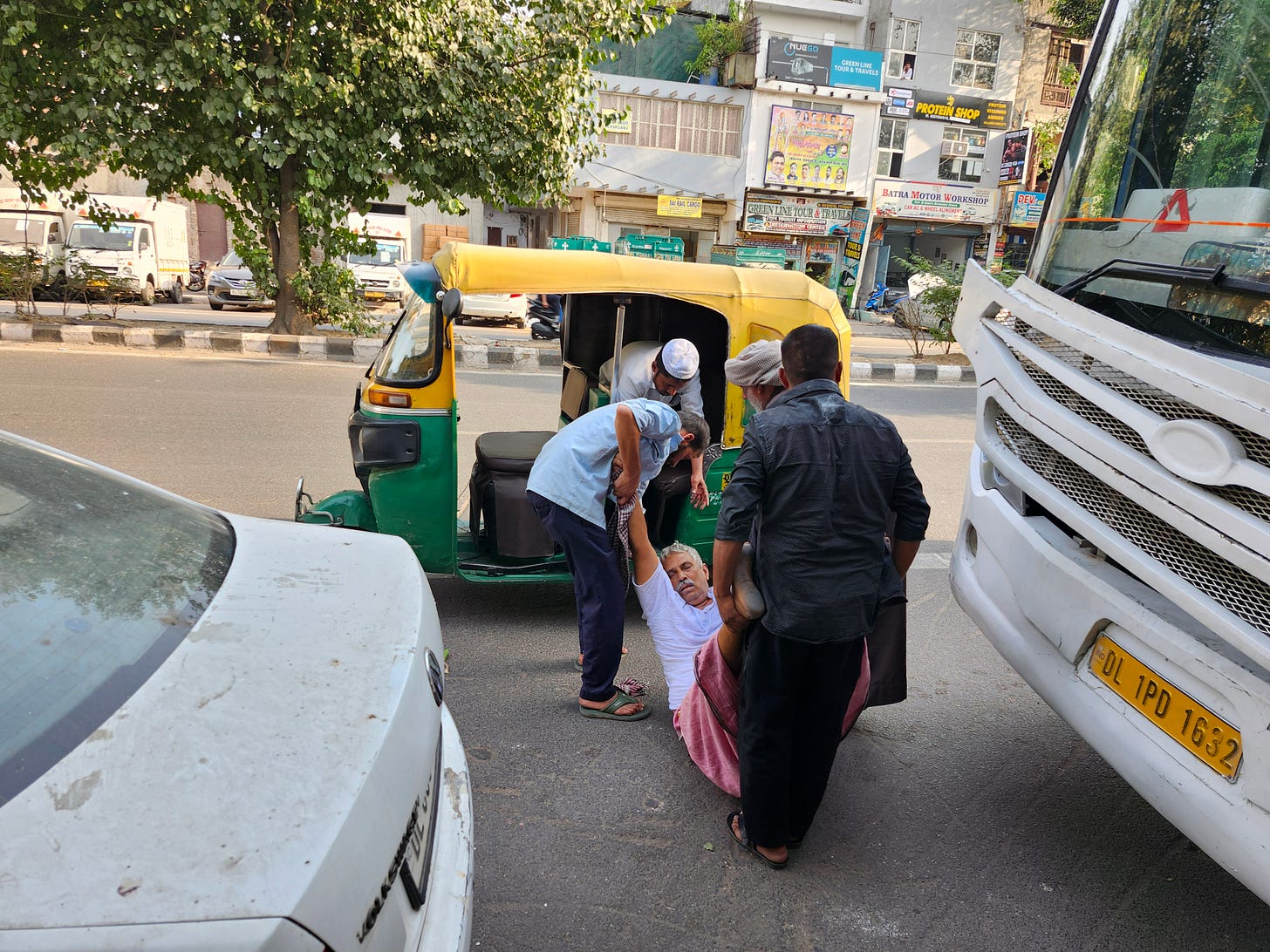
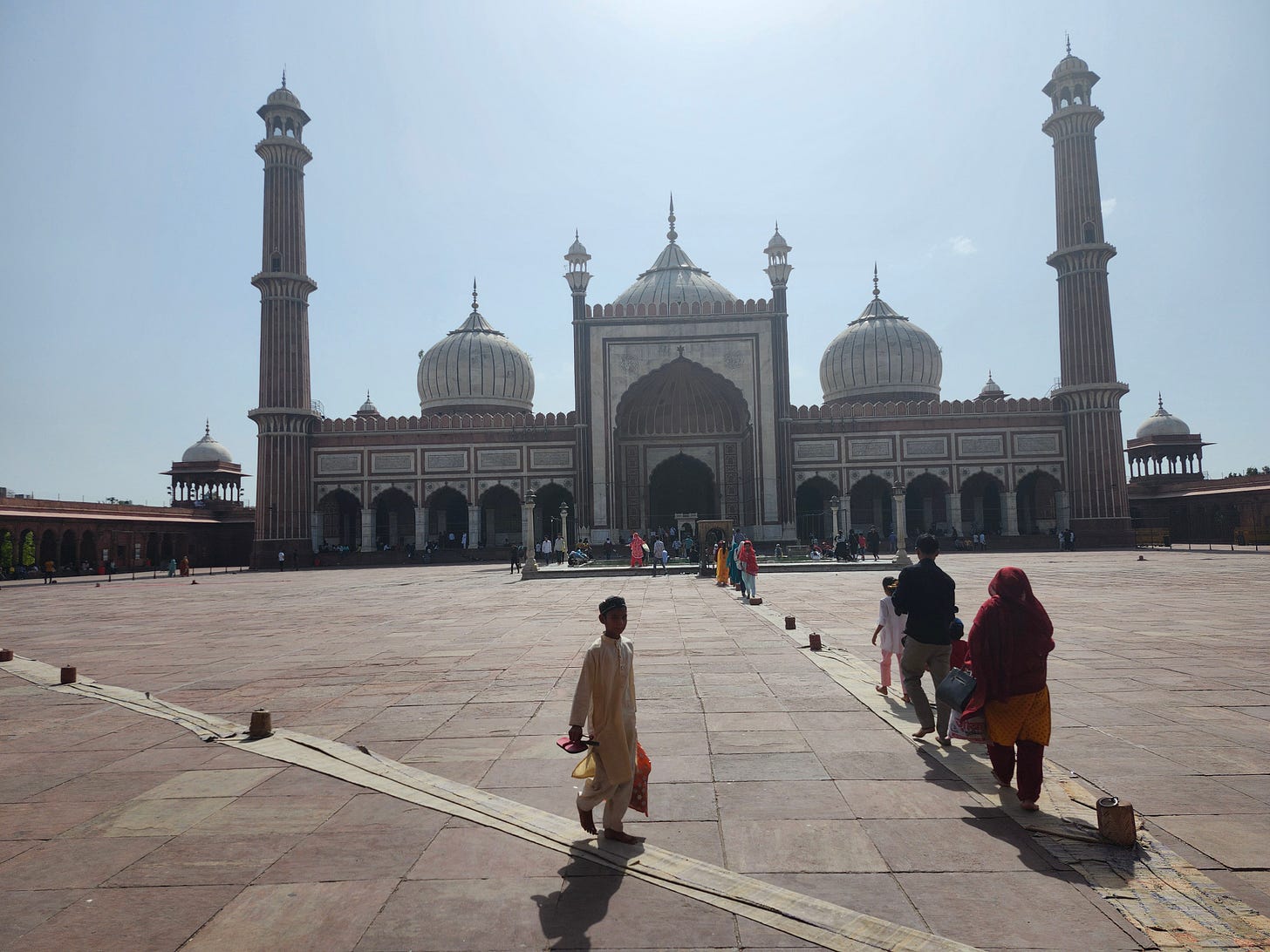



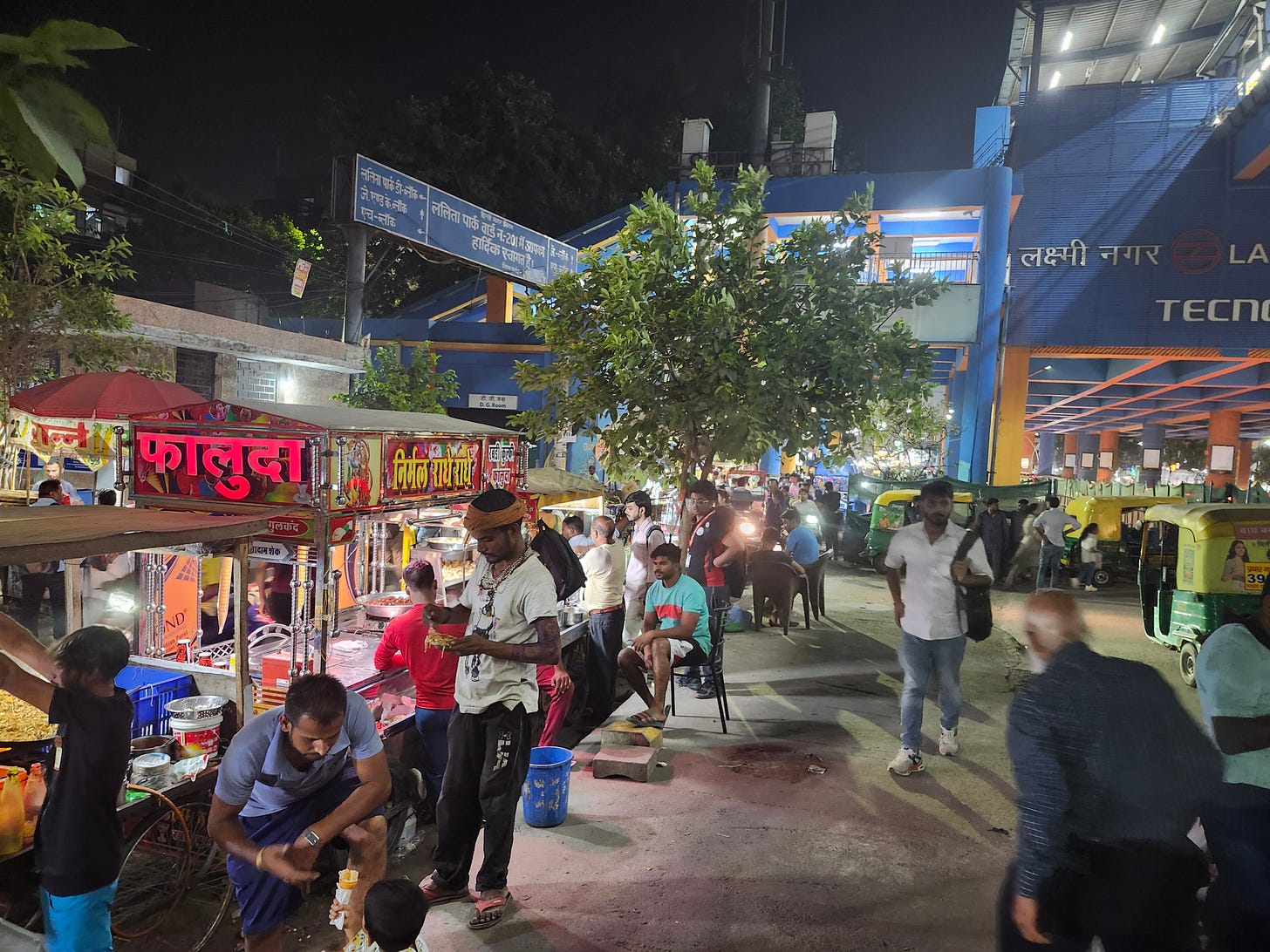
Sam, you are a simply wonderful travel journalist-. You really are! I've had so much enjoyment and edification reading this series. There are so many memorable sights youve relayed, so many interesting people you met, so much history and culture...
I think Delhi was a capstone. The Jain bird hospital, the apex of that. You said, "Humans can be pretty freakin’ awesome creatures sometimes." Indeed that gives me hope too and I feel you skirt something very very profound there. A realization of our true nature which is something only partly human. A bright center radiating out and becoming all life forms.
i want to share a link to your india travel trip articles on metafilter, but I can't figure out how to link to them either individually or as a whole, as there isn't the usual share link on the emails. they were so good to read and i really enjoyed especially the last one and the interviews with local experts. Bird hospital forever